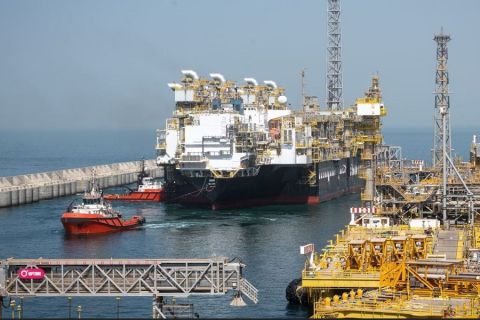MPD resolves a fundamental constraint in traditional drilling technology. A conventional fluid-circulating system is open to the atmosphere with mud pumped down the drillpipe flowing freely from the annulus at the surface. An MPD system closes this loop by capturing and redirecting the flow. The result of closing this loop is an immediate safety enhancement directing returns away from the rig floor while achieving a new level of well-pressure management. This system also offers a clear advantage in many applications where open-circulating systems have reached their performance limits.
The fundamental change of closing the loop is leveraged by a handful of commonly used hardware components and Weatherford’s advanced Microflux control system. With little change, the basic equipment package can be configured for applications ranging from early kick and loss detection or as a scalable response to automated wellbore pressure management.
Egyptian extremes
A harsh HP/HT environment compounded by a narrow drilling window between pore pressure and fracture gradient have made MPD the only solution for drilling an exploration well offshore Egypt.
HP/HT formations with narrow windows are challenging, and one influx could result in well-control procedures. This extreme environment confounded the conventional mud-weight-management methods. But MPD enabled accurate and confident navigation through an extremely tricky well profile where pore pressure ranged from approximately 17.6 to 18.4 lb/gal, and the fracture gradient ranged approximately 18.0 to 18.6 lb/gal.
The overlap in these numbers presents an impossible situation for conventional techniques and would have required many additional casing strings to navigate the variations in the drilling window. In short, conventional techniques could not drill an economically viable well.
To manage pressure and drill the undrillable well, the MPD system used a mud weight marginally below bottom-hole pressure and adjusted annular backpressure at the surface. Adding or releasing pressure on the annular side of the closed-loop system results in an almost immediate response in bottomhole pressure. This process also works in reverse to enable downhole pressure to be detected rapidly at the surface. Fast detection and mitigation of pressure fluctuations allow the wellbore to be balanced before conditions escalate into a kick- or loss-control event.
The MPD system uses a unique approach that calculates the mass flow of fluid into and out of the hole and uses this balance to control the automated drilling model. This makes it possible to determine actual downhole pressures.
The system was used to drop the pressure in small increments until a microinflux was detected. Knowing actual pore pressures permitted real-time calibration of the drilling mud weights and bottomhole equivalent circulating density, which resulted in a greater degree of confidence to drill through challenging sections.

Early kick detection provided by real-time pressure and flow data identifies hazards in narrow drilling windows, often found in deepwater environments, before they can escalate into well control events. (Images courtesy of Weatherford International Ltd.)
Efficiency gains came with the elimination of traditional points of nonproductive time (NPT), such as long flow checks on connections caused by hole ballooning and the time and expense of mud-density adjustments. Correct identification of surface-fluid-management issues – typically misdiagnosed as downhole issues – avoided lengthy well-control procedures and potential NPT.
The MPD operation eliminated significant NPT and eliminated pore pressure and fracture gradient uncertainty. The operator gained confidence that fluctuations were caused by ballooning and not a kick, which eliminated the need for extensive flow checks on connections.
This is the fifth challenging Mediterranean well drilled successfully by the operator using MPD methodology.
New Zealand depleted reservoir
A stacked reservoir sequence with near-virgin pressures and highly depleted zones made infill drilling in a New Zealand reservoir problematic. The mud weights required to control higher pressure sections would have resulted in the breakdown of the lower pressured formations.
In two wells, MPD technology enabled drilling with lower mud weights and allowed formation pressures to be measured to establish formation leak-off pressures.
MPD provided exact details of the formation pressures to help reduce fluid losses to the reservoir. Post-drilling logs showed the losses that occurred were related to fractures rather than to formation breakdown, which was avoided by the lower fluid weights. Clear kick indications were encountered at much lower pressures, and reservoir and drilling data were improved as a result of the lower mud weights used.
In addition, data on dynamic stress caging and lost-circulation-material (LCM) squeezing also were obtained. The MPD system enabled dynamic integrity testing of formations to be conducted while pumping at full drilling rates. It also enabled loss rates to be established by slowly increasing choke pressure.
Moving forward
In Indonesia, the first deepwater MPD system was facilitated by the SeaShield Model 7875 below-tension ring, rotating control device (RCD). The RCD typically is used to cap the well to contain and redirect fluid flow and is the first of its kind to address the unique requirements of risers and dynamically positioned drillships.
Weatherford’s MPD system is having a significant effect on what can be done with MPD and the wellbore pressure information that can be acquired.
Recommended Reading
E&P Highlights: April 22, 2024
2024-04-22 - Here’s a roundup of the latest E&P headlines, including a standardization MoU and new contract awards.
E&P Highlights: March 15, 2024
2024-03-15 - Here’s a roundup of the latest E&P headlines, including a new discovery and offshore contract awards.
E&P Highlights: Feb. 16, 2024
2024-02-19 - From the mobile offshore production unit arriving at the Nong Yao Field offshore Thailand to approval for the Castorone vessel to resume operations, below is a compilation of the latest headlines in the E&P space.
Deepwater Roundup 2024: Americas
2024-04-23 - The final part of Hart Energy E&P’s Deepwater Roundup focuses on projects coming online in the Americas from 2023 until the end of the decade.
BP: Gimi FLNG Vessel Arrival Marks GTA Project Milestone
2024-02-15 - The BP-operated Greater Tortue Ahmeyim project on the Mauritania and Senegal maritime border is expected to produce 2.3 million tonnes per annum during it’s initial phase.





